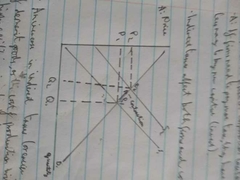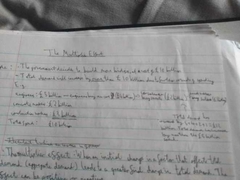![]()
![]()
![]()
Use LEFT and RIGHT arrow keys to navigate between flashcards;
Use UP and DOWN arrow keys to flip the card;
H to show hint;
A reads text to speech;
34 Cards in this Set
- Front
- Back
|
What are the aims of a government's macroeconomic policy? |
1) To reduce the large fluctuations in GDP, and maintain a low and stable rate of inflation, unemployment and Balance of payments. 2) To increase the long term productive capacity of the economy. |
|
|
What are the 3 types of policy a government can use? |
Monetary policy - changing interest rates and the money supply. Fiscal policy - Government taxes and spending to influence aggregate demand. Supply-side policy - policies to increase the productive capacity of the economy. |
|
|
Which if these are demand-side policies. |
Monetary policy and fiscal policy, as they both influence demand. |
|
|
What are the 3 largest areas of spending for the UK government? |
Pensions, health and education. |
|
|
What are the three largest taxes collected by the British Government? |
Income tax (£170bn) VAT (£133bn) National Insurance contributions (£115bn) |
|
|
What's the difference between direct and indirect taxes. |
A direct tax is a tax on income or wealth. E.g. Income tax, corporation tax. An indirect tax is a tax on spending, often thought of as a tax on goods and services. E.g. VAT, excise duties. |
|
|
What's the difference between progressive, proportional and regressive taxes? |
A progressive tax takes a greater percentage in tax the higher the income. A proportional tax has the same rate of tax in all income levels. A regressive tax has a higher rate of tax on lower incomes. |
|
|
Why are indirect taxes regressive? |
The amount paid us a percentage of the items value, and so is the same for everyone. This means that it has less impact in those who own more, as they spend a lower percentage of their income on E.g. VAT. |
|
|
Why is income tax progressive? |
Direct taxes such as income taxes are progressive as those with higher incomes pay a higher percentage of their income in tax. |
|
|
What is austerity? |
Widespread cuts to government spending/increased taxation due to large national debt/budget deficit. |
|
|
Using a diagram, show the effect of a rise in income tax on the labour market. |

|
|
|
How will a rise in corporation tax affect investment? |
If firms need to pay more tax, they will have a small net profit, and so Les money it but be capital (invest). |
|
|
Show the effect of an indirect tax on demerit goods on the market for alcoholic drinks. |

|
|
|
Who pays indirect taxes? |
Producers. |
|
|
What is fiscal policy? |
The use of changes in tax and government spending to influence the level of economic activity at a macro level. |
|
|
What are the Spring and autumn statements? |
Speechs where the Chancellor of the Exchequer announces plans for taxes and government spending in the next fiscal year. |
|
|
What are the three outcomes if a government budget? |
Budget deficit: Government spending is greater than tax revenue. Budget surplus: Government spending is less than tax revenue. Balanced budget: government spending is equal to tax revenue. |
|
|
What is expansionary fiscal policy? |
Cuts in taxes and/or increases in government spending to increase economic growth. Must lead to a budget deficit. |
|
|
What is contractionary fiscal policy? |
Tax rises or cuts in government spending to decrease inflationary pressures by reducing economic growth. Must lead to a budget surplus. |
|
|
What is the effect of a budget surplus? |
This will reduce the level of total spending in the economy and thus reduce inflation. This may lead to a fall in the Current account deficit. However, there may be a rise in unemployment and a fall in economic growth. |
|
|
What is the effect of a budget deficit? |
This will increase the level of total spending in the economy and thus reduce unemployment and help achieve economic growth. |
|
|
What is the effect of a balanced budget? |
It will likely have no effect on total spending in the economy. |
|
|
When the economy is in recession what should the government do? |
Adopt expansionary fiscal policy. |
|
|
The total amount of government borrowing is called the... |
National debt. |
|
|
If government spending is greater than tax revenue in any given year then the government will have to.. |
Fund the shortfall by borrowing. This is called the Public sector Net Cash Requirement. |
|
|
Why are high levels of debt a problem? |
Interest is paid out of tax revenue and thus imposes an opportunity cost e.g. in terms of spending on healthcare. It may reduce confidence in the government's ability to manage the economy, leading to reduced confidence, consumer spending and investment. |
|
|
What is the multiplier effect? |
When an initial change in a factor that affects AD leads to a greater final change in AD. The effect can be positive or negative. |
|
|
Give an example of the multiplier. |

|
|
|
Why does the government spend money? |
To affect the level of AD To provide merit goods which would be underprivileged if left to the private sector. To correct market failure. To encourage equity. To encourage efficiency. |
|
|
Why do governments tax? |
To raise money to finance spending. To influence the level of AD. To discourage the consumption of demerit goods. To redistribute income and wealth across the economy. |
|
|
Why might opportunity cost be a problem with fiscal policy? |
An increase in spending in a particular area or a cut in taxes may lead to spending cuts or tax raises in other areas. Even if the government borrows to cover the extra cost, this will have to be repaid some day, leading to an opportunity cost in the future. |
|
|
Give an example for opportunity cost in fiscal policy. |
1) If import tax is reduced, household swill spend more on imports and so the UK's CAD will increase. 2) If corporation tax is increase, investment will fall. 3) An increase in income tax will lead to workers demanding more pay, and therefore cost push inflation. |
|
|
What other problems are their with fiscal policy? |
1) Forecasting and time lags: there are problems with predicting the effect of changes in spending and taxes in AD, and how long it takes for the policies to take effect. 2) The size of the multiplier: If the multiplier is small then a change in spending it taxes will not have a large effect on GDP. |
|
|
What are policy conflicts? |
Policy conflicts are when the economy is experiencing problems that either expansionary or contractionary will fix some of, whilst excerbating others. E.g. High unemployment (solved by expansionary fiscal policy, excerbated by contractionary fiscal policy) and high inflation (solved by contractionary fiscal policy, excerbated by expansionary). |

